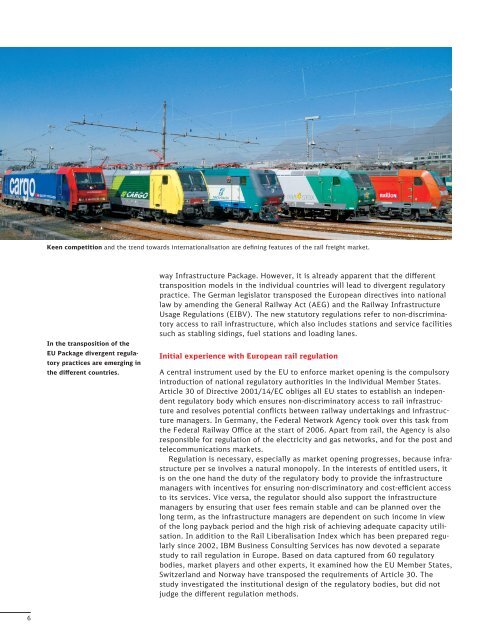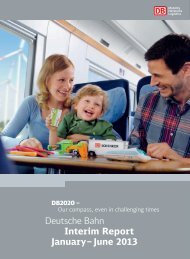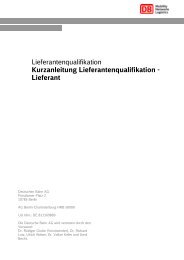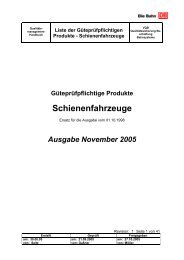Competition Report 2006 - Deutsche Bahn AG
Competition Report 2006 - Deutsche Bahn AG
Competition Report 2006 - Deutsche Bahn AG
Create successful ePaper yourself
Turn your PDF publications into a flip-book with our unique Google optimized e-Paper software.
6<br />
Keen competition and the trend towards internationalisation are defi ning features of the rail freight market.<br />
In the transposition of the<br />
EU Package divergent regulatory<br />
practices are emerging in<br />
the diff erent countries.<br />
way Infrastructure Package. However, it is already apparent that the diff erent<br />
transposition models in the individual countries will lead to divergent regulatory<br />
practice. The German legislator transposed the European directives into national<br />
law by amending the General Railway Act (AEG) and the Railway Infrastructure<br />
Usage Regulations (EIBV). The new statutory regulations refer to non-discriminatory<br />
access to rail infrastructure, which also includes stations and service facilities<br />
such as stabling sidings, fuel stations and loading lanes.<br />
Initial experience with European rail regulation<br />
A central instrument used by the EU to enforce market opening is the compulsory<br />
introduction of national regulatory authorities in the individual Member States.<br />
Article 30 of Directive 2001/14/EC obliges all EU states to establish an independent<br />
regulatory body which ensures non-discriminatory access to rail infrastructure<br />
and resolves potential confl icts between railway undertakings and infrastructure<br />
managers. In Germany, the Federal Network Agency took over this task from<br />
the Federal Railway Offi ce at the start of <strong>2006</strong>. Apart from rail, the Agency is also<br />
responsible for regulation of the electricity and gas networks, and for the post and<br />
telecommunications markets.<br />
Regulation is necessary, especially as market opening progresses, because infrastructure<br />
per se involves a natural monopoly. In the interests of entitled users, it<br />
is on the one hand the duty of the regulatory body to provide the infrastructure<br />
managers with incentives for ensuring non-discriminatory and cost-effi cient access<br />
to its services. Vice versa, the regulator should also support the infrastructure<br />
managers by ensuring that user fees remain stable and can be planned over the<br />
long term, as the infrastructure managers are dependent on such income in view<br />
of the long payback period and the high risk of achieving adequate capacity utilisation.<br />
In addition to the Rail Liberalisation Index which has been prepared regularly<br />
since 2002, IBM Business Consulting Services has now devoted a separate<br />
study to rail regulation in Europe. Based on data captured from 60 regulatory<br />
bodies, market players and other experts, it examined how the EU Member States,<br />
Switzerland and Norway have transposed the requirements of Article 30. The<br />
study investigated the institutional design of the regulatory bodies, but did not<br />
judge the diff erent regulation methods.

















